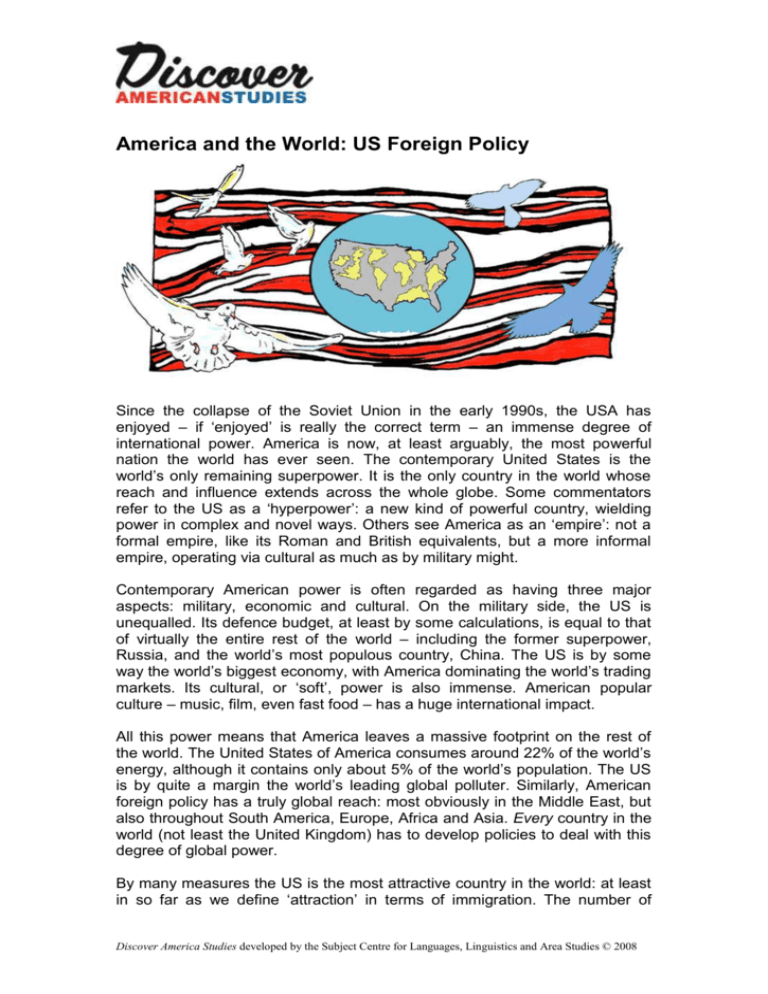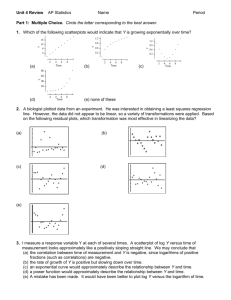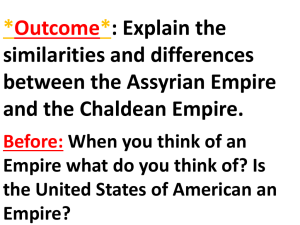America and the World: US Foreign Policy and American Studies
advertisement

America and the World: US Foreign Policy Since the collapse of the Soviet Union in the early 1990s, the USA has enjoyed – if ‘enjoyed’ is really the correct term – an immense degree of international power. America is now, at least arguably, the most powerful nation the world has ever seen. The contemporary United States is the world’s only remaining superpower. It is the only country in the world whose reach and influence extends across the whole globe. Some commentators refer to the US as a ‘hyperpower’: a new kind of powerful country, wielding power in complex and novel ways. Others see America as an ‘empire’: not a formal empire, like its Roman and British equivalents, but a more informal empire, operating via cultural as much as by military might. Contemporary American power is often regarded as having three major aspects: military, economic and cultural. On the military side, the US is unequalled. Its defence budget, at least by some calculations, is equal to that of virtually the entire rest of the world – including the former superpower, Russia, and the world’s most populous country, China. The US is by some way the world’s biggest economy, with America dominating the world’s trading markets. Its cultural, or ‘soft’, power is also immense. American popular culture – music, film, even fast food – has a huge international impact. All this power means that America leaves a massive footprint on the rest of the world. The United States of America consumes around 22% of the world’s energy, although it contains only about 5% of the world’s population. The US is by quite a margin the world’s leading global polluter. Similarly, American foreign policy has a truly global reach: most obviously in the Middle East, but also throughout South America, Europe, Africa and Asia. Every country in the world (not least the United Kingdom) has to develop policies to deal with this degree of global power. By many measures the US is the most attractive country in the world: at least in so far as we define ‘attraction’ in terms of immigration. The number of Discover America Studies developed by the Subject Centre for Languages, Linguistics and Area Studies © 2008 people queuing to enter the US is extraordinary. Between 2000 and 2005, it is estimated that some 3.1 million illegal immigrants entered the United States. For many of the world’s downtrodden people, America still holds out the prospect of economic advancement. America is additionally, of course, the world’s most hated country. Anti-Americanism has grown on a massive scale during the early part of the twenty-first century. The invasion of Iraq in 2003 was probably the most controversial, and internationally unpopular, American foreign policy decision in history. Despite its vast power, the US is not unchallenged. The 9/11 attacks showed its vulnerability to small groups of international terrorists. In the longer term, the rise of China represents a major potential threat to America’s international power. The future for American foreign policy seems likely to involve adjustment to such various threats, along with efforts to retain or regain the loyalty of its long-standing allies. As a student of American foreign policy, you will gain vital insights into the operation of world politics. You will be studying the very heart of global power, testing crude understandings and interpretations of American foreign policy. You will also learn how American foreign policy is made: by the President, by multinational American corporations, by the US Congress, even by the American people. There is no more important or exciting task than this. John Dumbrell The following websites provide excellent introductions to the kinds of issues you will encounter as a student of American foreign relations: http://www.cfr.org/ (Council on Foreign Relations) http://www.fpa.org/ (Foreign Policy Association) http://www.state.org/ (State Department) Discover America Studies developed by the Subject Centre for Languages, Linguistics and Area Studies © 2008











